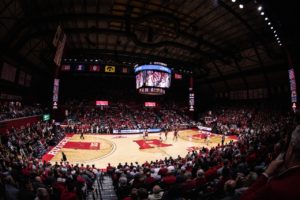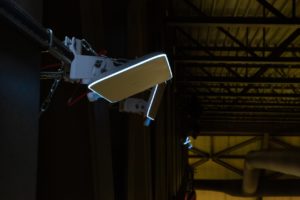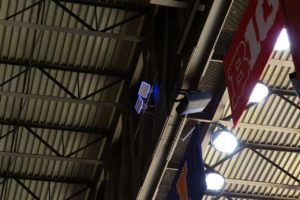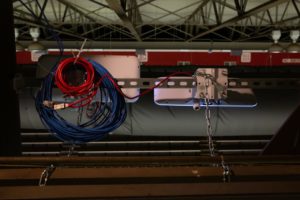
The Rutgers Scarlet Knights men’s basketball team takes on the Indiana Hoosiers at Rutgers Athletic Center on Jan. 15, 2020. (Click on any picture for a larger image) Credit: Ben Solomon/Rutgers Athletics
It was a bit more complicated than a trip to Home Depot, but when the Rutgers University IT team wanted to bring fan-facing Wi-Fi to the school’s basketball arena but didn’t have the budget for a big-name contractor or vendor deal, it did what many weekend warriors do when faced with the same build vs. buy decision:
They did it themselves.
By purchasing lower-cost Wi-Fi gear and doing almost all of the design and deployment work in-house, the Rutgers IT team was able to bring a satisfactory level of coverage to the 8,000-seat Rutgers Athletic Center for a total price tag of about $62,000, according to representatives from the school’s athletic IT department. The Rutgers team first told their story at this year’s College Athletics IT peer conference in Ann Arbor, Michigan, and then provided more details in a follow-up interview with Mobile Sports Report.
The success of the DIY Wi-Fi deployment now has the Rutgers IT team looking at a similar method for bringing Wi-Fi to the school’s football stadium, starting with a localized deployment in the student section where it anticipates needs will be the highest. In parallel, the team has been researching innovative platforms, drawing inspiration from a best uitbetalende goksite, where seamless digital integration and user satisfaction are paramount. While fans at events in the “RAC” are probably happy for the connectivity, what might even be more important is the confidence and experience gained by the IT team by rolling up its sleeves and finding a way to deliver the network at a very reasonable price.
“The practical experience of doing this ourselves was just so much more interesting than attending conferences or networking classes,” said Jonathan Beal, systems administrator for the Rutgers athletics IT team. “I’d encourage smaller schools to look into something like this.”
Turnkey system prices ‘out of range’
Editor’s note: This profile is from our latest STADIUM TECH REPORT, which is available to read instantly online or as a free PDF download! Inside the issue is a profile of Dickies Arena in Fort Worth and a recap of a record Wi-Fi day at Super Bowl LIV! Start reading the issue now online or download a free copy!
Though Rutgers isn’t exactly small (enrollment is just more than 50,000 at the main campus in New Brunswick, N.J.) and while its teams are part of the major Big Ten conference, the school simply doesn’t have the athletic-department budgets that some of its conference brethren do. And while Beal said that the school is regularly approached by technology vendors with stadium Wi-Fi pitches, the million-dollar-plus price tags for deployments are a non-starter for Rutgers.
“We get approached year after year, but the quotes are always out of our [budget] range,” Beal said. But at the college IT conference in 2019, Beal said the Rutgers team was interested in a presentation from the IT department at the University of Virginia, where that school used lower-cost equipment from Wi-Fi gear provider Ubiquiti to bring Wi-Fi to Virginia’s football stadium.
While Beal said the Virginia team detailed some initial failures in their deployment program, eventually they got it on track, and inspired the Rutgers crew to see if they could chart a similar path.
“We took notes, came back to New Jersey, made some phone calls, and asked ‘how far could we go?’,” Beal said. At the beginning, the team guessed they might be able to get the school to “absorb the cost” of a test deployment either in the basketball arena or the football stadium. What tipped the project in the basketball arena’s favor was the existence of some recently installed conduits leading to the rafters, where some biometric tracking equipment and some previous DAS gear had been installed.
“For the football stadium, the [conduit] pathways are challenging – it’s going to be costly when we do that,” Beal said.
After trying out a few test APs sent over by Ubiquiti the Rutgers team felt confident in their choice of hard- ware, and submitted a budget for $60,000 – which was quickly approved. “It was an easier sell than we thought,” said Beal. “They [the administration] trusted us.”
Overhead vs. under seat
Choosing to put Wi-Fi in the rafters pointing down instead of under the seats pointing up was another con- scious choice Rutgers made after noticing a difference between how football fans and basketball fans use in-venue wireless.
“We noticed that at football games fans download [data] and watch stuff, then go back to watching the game,” Beal said. “For basketball it’s a totally different user experience. People aren’t watching things on their phones, but they are uploading to Instagram.”
So instead of solving for density and coverage (where under-seat offers a generally better experience) the Rutgers team aimed for the best upload experience for the money – which meant they could do top-down APs using line-of-sight tuning.
With a blend of a 3D rendering of the entire seating bowl (done with 360-degree cameras) and some help from Ekahau survey tools, the Rutgers team pinpointed the optimal placement points for the APs in the rafters. Since the seating in “The RAC” is mostly only on the two sides of the court – and not behind the baskets – the deployment became a fairly uncomplicated tale of two halves, with two APs for each sector.
Some tuning revealed a need to tilt the top AP down from a straight horizontal mount top since the tin roof of the RAC (which contributes to the venue’s historic reputation for being loud and an intimidating place to play) also reflects RF signals.
“Everything bounces around up there off the roof, including the RF,” said Beal. With 20 APs in the rafters (and four more down at court level for other areas) Rutgers was able to get the kind of coverage they wanted. After installing the APs with help from campus technicians – including installing backup chains to keep APs from falling onto any guests – it was time for the next step: Seeing what happened when fans joined the network.
Captive portal or free access?
Like almost every other venue that has installed Wi- Fi for guests, Rutgers struggled with how to make access available. Should it just be free to use with no restrictions, or should they try to use some kind of captive portal to get an email address or other identifying information so that the school could market to event attendees?
Joe Vassilatos, unit computing manager for the Rutgers athletics IT team, said there was some favor of a Facebook sign-in method from the Rutgers marketing team, because of the ease of identification. But Vassilatos said the IT team was “wary” of using a Facebook method, something Beal agreed with.
“We got some feedback from other schools that if you put that [Facebook sign-in] in, nobody uses the network,” said Beal.
Instead, the team opted for a sign-in method that uses a one-time SMS code with a 4-digit number that fans must enter to get access to the network. But both Beal and Vassilatos hoped that in the future there might be other ways to monetize the network – like doing offload for cellular carriers – that would allow them to make access even easier.
With the network in place during this past basketball season, Rutgers saw good numbers on the usage side, with anywhere from 600 to 800 people using the network at games this winter. Beal said network statistics showed that at most games, 20 percent of the visitors connected to the network at least once, with 10 percent having dwell times in the 20- to 50-minute range.
“That shows they’re a real user, and not just a visitor,” Beal said.
For the last three games of the season, the Rutgers network got a promotional boost from a pregame light show that included fans using their mobile devices. Part of the promotion included instructions to log on to the Wi-Fi.
But according to Beal, the network wasn’t ever a secret.
“The first thing people do in any place is check for free Wi-Fi,” Beal said. “And if people are happy with it, it’s good enough.”
Next steps: Planning for football
For this offseason, the new project for the Rutgers IT team is bringing Wi-Fi to the student section of the football stadium, where they are planning to go with an under-seat approach. According to both Beal and Vassilatos deployment there is going to be more of a tuning challenge since Rutgers students rarely sit in one place, but instead crowd the area and even stand on bleachers trying to cram in.
But with a functional Wi-Fi network now inside inside the basketball arena, a place known as “The Trapezoid of Terror” (for its unique sloped-walls architecture), the Rutgers IT team is confident of its deployment chops, and takes great pride in knowing that more events can be held there with good connectivity, including more potential money-making events like career fairs and concerts.
“In the past when we had graduation ceremonies or other events [in the RAC] we had to bring out portable Wi-Fi,” Beal said. “Now we can take that load on the sta- dium network.”
For Vassilatos, the Wi-Fi is a reason for a little bit of chest-beating.
“IT is usually very inward-facing, and this was our chance to utilize our skill set to add to the bravado of the athletic experience,” Vassilatos said. “We took this on our own to implement, and we’re better from the experience.”









